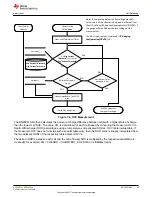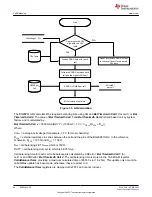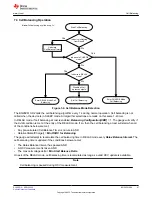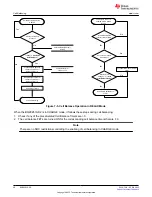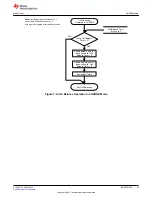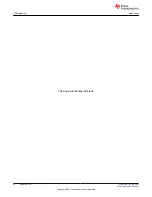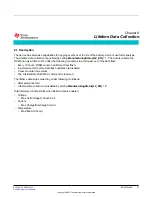
6.4.1 QMax Initial Values
The initial
QMax Pack
,
QMax Cell 0
, and
QMax Cell 1
values should be taken from the cell manufacturers' data
sheet multiplied by the number of parallel cells, and are also used for the
DesignCapacity
function value in the
Design Capacity
data flash value.
See the "Theory and Implementation of Impedance Track Battery Fuel-Gauging Algorithm" in the
Product Family Application Report
6.4.2 QMax Update Conditions
QMax update is enabled when gauging is enabled. This is indicated by the
GaugingStatus[QEN]
flag. The
BQ28Z610-R2 updates the no-load full capacity (QMax) when two open circuit voltage (OCV) readings are
taken. These OCV readings are taken when the battery is in a RELAXED state before and after charge or
discharge activity. A RELAXED state is achieved if the battery voltage has a dV/dt of < 4 µV/s. Typically it
takes 2 hours in a CHARGED state and 5 hours in a DISCHARGED state to ensure that the dV/dt condition
is satisfied. If 5 hours are exceeded, a reading is taken even if the dV/dt condition was not satisfied. The
GaugingStatus[REST]
flag is set when a valid OCV reading occurs. If a valid DOD0 (taken at a previous QMax
update) is available, then QMax will also be updated when a valid charge termination is detected.
Temperature
If
Temperature
is outside of the range 10°C to 40°C.
Delta Capacity
If the capacity change between suitable battery rest periods is less than 37%.
Voltage
If
CellVoltage2..1
is inside a flat voltage region. (See the
Support of Multiple Li-Ion Chemistries
with Impedance Track Gas Gauges Application Report
for the voltage ranges of other
chemistries.) This flat region is different with different chemistry. The
GaugingStatus[OCVFR]
flag indicates if the cell voltage is inside this flat region.
Offset Error
If offset error accumulated during time passed from previous OCV reading exceeds 1% of
Design Capacity
, update is disqualified. Offset error current is calculated as
CC Deadband
/
sense resistor value.
Several flags in
GaugingStatus()
are helpful to track for QMax update conditions. The
[REST]
flag indicates an
OCV is taken in RELAX mode. The
[VOK]
flag indicates the last OCV reading is qualified for the QMax update.
The
[VOK]
is set when charge or discharge starts. It will be cleared when the QMax update occurs, when the
offset error for a QMax disqualification is met, or when there is a full reset. The
[QMax]
flag will be toggled
when the QMax update occurs.
ITStatus2()
and
ITStatus3()
return the QMax and DOD (depth of discharge,
corresponding to the OCV reading) data.
6.4.3 Fast QMax Update Conditions
The Fast QMax Update Conditions are very similar to the QMax Update Conditions with the following
differences:
• Instead of taking two OCV readings for QMax update, Fast QMax update requires only one OCV reading
AND
• The battery pack should discharge > 10% RSOC.
The differences in requirements allow the Fast QMax feature to have a QMax update at the end of discharge
(given one OCV reading is already available and discharge < 10% RSOC) without a longer relax time after a
discharge event. The Temperature, Delta Capacity, Voltage, and Offset Error requirements for a QMax update
are still required for the Fast QMax update.
This feature is particularly useful for reducing production QMax learning cycle time or for an application
that is mostly in CHARGE or DISCHARGE state with infrequent relaxation. Setting
IT Gauging
Configuration[FAST_QMax_LRN]
= 1 enables Fast QMax during production learning only (that is,
Update
Status
= 6).
The DOD is taken for QMax at a high state-of-charge, then during discharge when at the steep portion of
the voltage curve (85–90% DOD). This allows a good estimation of DOD again. This DOD estimation during
discharge is used to update QMax immediately instead of needing a rest period first. The actual update to
Gauging
SLUUCO0 – APRIL 2022
BQ28Z610-R2
39
Copyright © 2022 Texas Instruments Incorporated





















